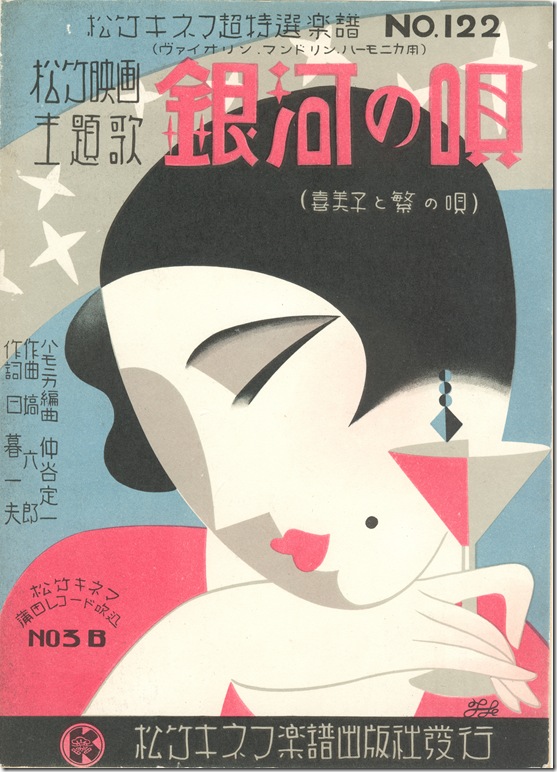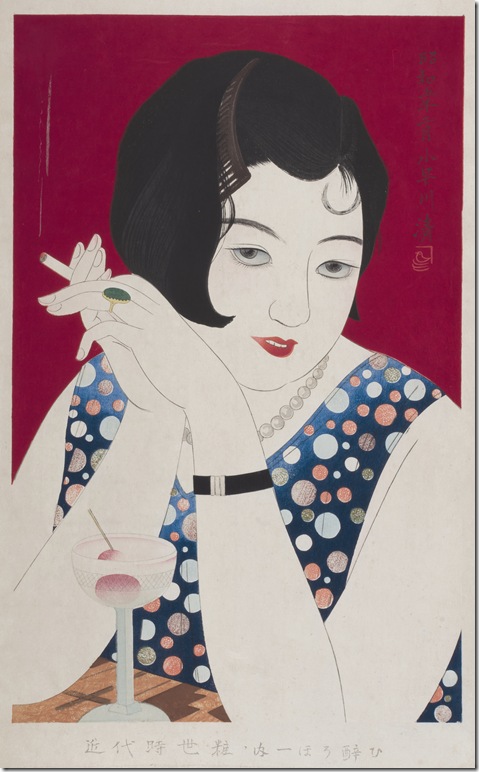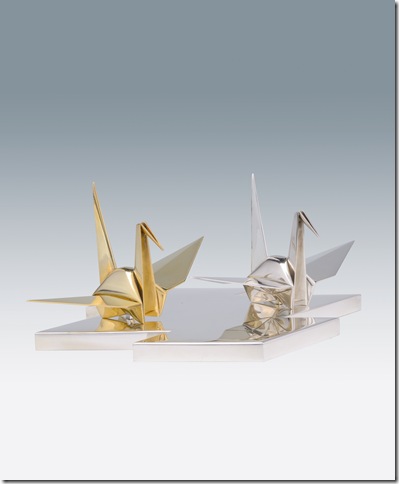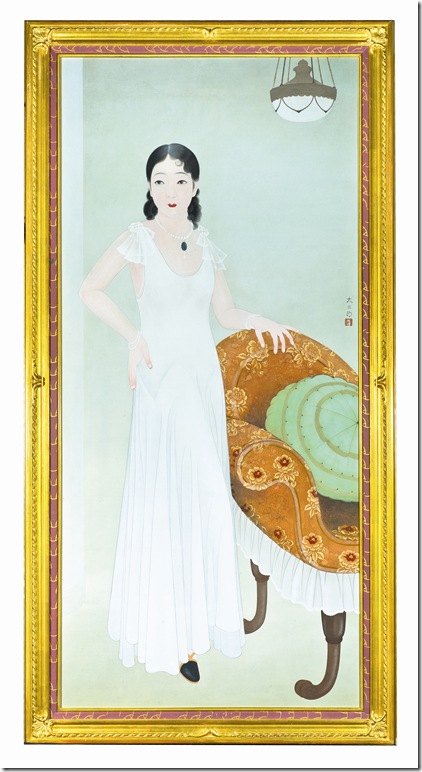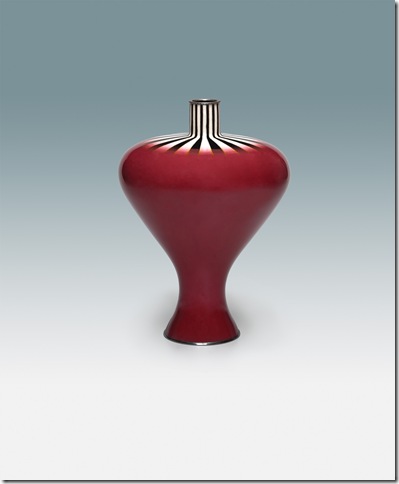A new art exhibit at The Society of the Four Arts skips the foreplay and leads with the most daring Art Deco while leaving the dirtiest (politics) out.
I walked in and there it was: a Japanese nude barely covered in black lace leaning back on a couch, and attended to by a younger female helper. Clearly, I had made a mistake, but some steps later another daring female stood showing her bared, voluptuous backside. Black heels arched, she sported a Louise Brooks hairdo and red lips.
Was I looking at Japan? Not particularly. More like Deco Japan.
The first exhibition of its kind held outside Tokyo, Deco Japan: Shaping Art and Culture, 1920-1945 opened Saturday with an army of textiles, sculpture ceramics, posters, paintings and woodblock prints to prove one point. Art Deco left a mark in this ancient country, believe it or not.
Its provocative aspect was decisively the hardest to digest by the Japanese government and the most conflicting, but leave it to Japan to marry the ancient and the modern, the traditional with the bold. When the Art Deco wave invaded every aspect of Japanese life, the past held on and made itself an indispensable part of it. The new looked to the old, and Japanese Art Deco was born.
The evidence left on textile is shown with a man silk jacket depicting a skyscraper design early in the show. Another jacket depicts scenes of movie sets with cameras rolling and light projectors while a third one features movie posters.
A copper vase depicting Egyptian dancers by Goto Komao is one of several ceramics showing a revival of themes from antiquity. This practice was common among Deco artists. In this vase, the figures appear lined up like a chorus line at a Parisian hall. Their arms and legs appear elongated and aside from eyes, they have no facial features.
Arches, one of the most distinguishable symbols of the style, appear repeatedly on a box made of copper, silver and gold depicting a fountain design. In Japan, the creation of public fountains represented progress and beauty.
Animals, such as the hare and the turtle, long associated with entities and admirable personality traits, found in Art Deco a new vessel to be reimagined. Such is the case with Fox Spirits by Tsuda Shinobu, depicting a pair of foxes featuring a characteristically long nose and tail. Their bodies just seem to flow following in a smooth curvy line. The fox is believed to be the messenger of Inari, the Shinto rice god.
The bull, a symbol of national strength, is depicted as a massive steady bronze block in Ornament of a Bull, by Hiramatsu Koshun, while the hare, protagonist of many Japanese fables, is portrayed as agile and speedy in Morimura Torizo’s Ornament of a Hare. The bull, heavy and unmovable, stands in big contrast with the aerodynamics and readiness of the hare, whose body features a tear-shaped gap.
If the artists and craftsmen were responsible for curing and satisfying this fever for all things Art Deco, the women of Japan were definitely responsible for spreading it, adopting everything from the berets and red lips to the furs and daring poses.
An upper-class young woman wears pearls matching her modern, sleeveless, white dress in a portrait by Nakamura Daizaburo. But it’s not her non-traditional attire, jewelry and red lipstick that shock the most. Her hand resting on her hip, exalting confidence and independence, does. A playful hair curl completes this implacable picture of a woman’s new social power.
Next to it hang three oversized paintings by Enomoto Chikatoshi depicting dancers at the Florida, a well-known dance hall in Tokyo, against a shimmering gold background. Notice the addition of fashionable accessories, such as fans, clutch purses and green earrings. The women sport made-up faces and elegant hairdos.
Later in the show we find a series of four small prints depicting female dancers each in ethnic clothing. We can hardly tell they are Japanese. One wears a red head scarf while another wears a multicolor dress with a turban over her head. A third one arches back, eyes closed, stretching one arm back and the other to the front. She stands on the front sole of her feet and wears a light dress with circle motifs in blue and orange. Curiously, the artist has left the little toe from her left leg out of the shoe. Like the other dancers, she has completely forgotten her inhibitions, but the drama of her pose makes her my favorite one. This is Dancer (from 1932) by Kobayakawa Kiyoshi.
Like the crimson hue and geometric shapes, contrasting images of women keep reappearing throughout the show. They hint at the thin line between elegant sophistication and obscene sensuality that the modern chic girl, or moga, constantly negotiated with.
One painting, however, departs from this dialogue to show us the ideal marriage of old and new. A woman descending from the stairs concentrates on putting on her silk white gloves. She carries a green clutch purse with gold framing and wears fur over her neck.
Next, we would expect to see her in a plunging dress of vivid colors or perhaps wearing a top hat and cigarette in hand. But she is not. She is wearing a traditional kimono and slippers with socks. Staircase is by Kobayakawa Kiyoshi.
More than 200 works encompass this exhibit running through Jan. 10. They were selected by Dr. Kendall Brown, an expert in modern Japanese art, and the majority of them belong to Robert and Mary Levenson of Clearwater.
Looking at them on Saturday, a group of ladies began exchanging stories from the old days, finding similarities between the dress on a painted girl and one they saw someone wear many years ago. One visitor seemed to regret not making it to Japan this year while another remembered studying Japanese at some point. And a picture reminded a lady of a green kimono given to her as a gift that she has yet to wear.
With Deco Japan exhibit organizers wanted to introduce us Westerners to the obscure face of an Art Deco that lived thousands of miles away pre-World War II. They will be happy to hear the nice feedback and to know the audience learned something new. But judging from the memory-evoking moments and personal association I witnessed, it seems they already got more.
Deco Japan: Shaping Art and Culture, 1920-1945, runs through Jan. 10 in the Esther O’Keefe Gallery at the Society of the Fourt Arts, Palm Beach. Admission: $5. Hours: 10 a.m. to 5 p.m. Monday through Saturday; 1 p.m. to 5 p.m. Sunday. Call 655-7226 or visit www.fourarts.org for more information.
***
As a further service to our readers, here is a Spanish translation of the review above:
La cara oscura de Japon al Deco se ve por primera fuera de Tokyo
Una nueva exposicion en la Sociedad de las Cuatro Artes guia con el arte deco mas atrevido dejando afuera lo mas sucio: la politica.
Alli estaba al entrar: una japonesa desnuda, cubierta inutilmente por un encaje negro, reclinada en un sofa mientras es atendida por una ayudante mas joven. Obviamente habia cometido un error pero unos pasos mas tarde otra mujer totalmente desnuda se paraba mostrando su corpulenta espalda. Llevaba un corte de pelo a la Louise Brooks, labios rojos y sus tacones negros arqueados.
Estaba mirando a Japon? No particularmente. Esto es Japon al Deco.
Deco Japan: Shaping Art and Culture, 1920-1945 es la primera exposicion de su tipo que se haya visto fuera de Tokyo. Abrio el sabado en The Society of the Four Arts con una procesion de esculturas ceramicas, textiles, carteles, pinturas e impresos para comprobar una cosa. El Arte Deco dejo su huella en este antiguo pais, crealo o no.
Su aspecto provocativo fue, sin duda, lo mas dificil de digerir por el govierno japones y lo mas conflictivo pero dejemoscelo a Japon el casar lo antiguo con lo moderno, lo tradicional con lo atrevido. Cuando la ola del Arte Deco invadio todo aspecto de la vida japonesa, el pasado se agarro y se hizo una parte indispensable de ella. Lo nuevo se volteo a lo viejo y el Arte Deco japones nacio.
La evidencia que dejo en los textiles se muestra temprano en la exposicion con una chaqueta de seda de hombre que lleva un diseño de un rascacielos. Otra chaqueta muestra escenas de un rodaje de una pelicula con dibujos de camaras rodando y proyectores mientras que una tercera pieza lleva carteles publicitarios de peliculas.
Un jarron de cobre enseñando bailarines egypcios, por Goto Komao, es una de varias ceramicas que muestra el avivamiento de temas de la antigüedad. Esta era una practica comun de los artistas deco. En el jarron, las figuras aparecen en una fila como un coro de baile en un salon parisiano. Sus brazos y piernas lucen alargadas y aparte de ojos no tienen facciones.
Los arcos, uno de los simbolos mas distinguibles de este estilo, aparecen repetidamente en un cofre hecho de cobre, plata y oro con un diseño de una fuente. En Japon, la creacion de fuentes publicas representaban progreso y belleza.
Animales como la liebre y la jicotea, los cuales han sido asociados por largo tiempo con dioses, seres y rasgos humanos sobresalientes, encontraron en el Arte Deco una nueva vena con la cual ser reinventados. Este es el caso de Fox Spirits (Espiritus de Zorras) por Tsuda Shinobu, donde el cuerpo de un par de zorras parece flotar siguiendo una curva suave. Sus caracteristicas narices y colas tambien se notan largas en una linea continua. Se cree que la zorra es la mensajera de Inari, el dios Shinto del arroz. El toro, un simbolo de fortaleza nacional, se muestra masivo como un bloque de bronze en una pieza titulada Ornament of a Bull (Ornamento de un Toro) por Hiramatsu Koshun. Mientras tanto, la liebre, protagonista de muchas fabulas japonesas, se muestra agil y veloz en Ornament of a Hare (Ornamento de una Liebre) por Morimura Torizo. El toro, inmovil y pesado, aparece en directo contraste con la diligencia de la liebre, cuyo cuerpo tiene una abertura en forma de lagrima.
Si bien los artistas y artesanos se encargaron de curar y satisfacer la fiebre por todo aquello Arte Deco, las mujeres de Japon definitivamente fueron responsables de regarla, adoptando todo desde boinas francesas y creyones rojos hasta pieles y poses frescas.
Una mujer de clasa alta lleva perlas que pegan con su moderno vestido blanco escotado en un retrato por Nakamura Daizaburo. Mas no es lo poco tradicional de su vestido ni las joyas ni sus labios rojos que asombran mas. Es su mano descansando en su cadera, la cual parece gritar a lo alto su seguridad en si misma y su independencia. Un rizo de pelo jugueton cae sobre su frente y completa esta imagen impecable del nuevo poder social de una mujer.
A su lado cuelgan tres pinturas grandes con fondo dorado por Enomoto Chikatoshi las cuales capturan bailarines en el Florida, un famoso salon de baile en Tokyo. Se suman los accesorios de moda como los abanicos, bolsos de mano y arêtes verdes. Las mujeres todas llevan el mismo maquillaje y peinados elegantes.
Mas tarde en la exposicion, encontramos una serie de cuatro impresos pequeños mostrando mujeres bailando en lo que parece ropa originaria de otra region. Las mujeres casi no lucen japonesas. Se ven mas exoticas. Un panuelo rojo adorna la cabeza de una mientras que otra lleva un vestido multicolor con un turbante. Una tercera mujer se arquea hacia atras con los ojos cerrados y extiende un brazo hacia atras dejando el otro delante. Lleva puesto un vestido claro con circulos en naranja y azul y se mantiene en el metatarso de sus pies en perfecto balance. Curiosamente el artista ha dejado el dedo chiquito de su pie izquierdo afuera del zapato. Como las otras bailarinas, ella ha olvidado completamente sus inhibiciones pero es su dramatica pose que la convierte en mi favorita. Este impreso del 1932 se titula Dancer (Bailarina) y es por Kobayakawa Kiyoshi.
Como el tono carmin y las figuras geometricas, imagenes contrastantes de la mujer siguen apareciendosenos atraves de la exposicion. Insinuan la linea estrecha entre la sofisticacion elegante y la sensualida obscena con la que la chica moderna japonesa o “moga” negociaba constantemente.
Un cuadro, sin embargo, abandona este dialogo para mostrarnos como luce la union ideal de lo viejo con lo nuevo. Una mujer desciende por la escalera concentrada en ponerse sus guantes blancos de seda. Carga bajo el brazo su bolso de mano verde con detalles dorados y cubre su cuello con piel. Esperariamos verla en un vestido largo de colores vividos o con cigarro en mano y sombrero de copa pero no es asi. Lleva puesto un kimono tradicional y chancletas con medias. Staircase (Escalinata) es por Kobayakawa Kiyoshi.
La exposicion comprende mas de 200 trabajos que estaran en publico hasta el 10 de Enero y en su mayoria pertenen a Robert Levenson y Mary Levenson de Clearwater, Florida. Fueron elegidos por el doctor Kendall Brown, un experto en arte japones moderno.
Mirandolos el sabado, un grupo de señoras comparaban historias de los viejos tiempos y encontraban similitudes entre el vestido en un cuadro y otro que vieron alguien usar hace años. Otra visitante expresaba pena al no poder ir a Japon este año mientras que otra recordaba haber estudiado japones en algun momento de su vida.
Y otra imagen hizo recordar a una señora del kimono verde que recibio como regalo y que aun no se ha puesto.
Con Deco Japan los organizadores de la exposicion quicieron presentarnos la cara oscura de un Arte Deco que vivio a miles de millas de aqui antes de la segunda Guerra Mundial. Estaran contentos al escuchar la reaccion positiva del publico y que este haya aprendido algo nuevo. Pero a juzgar por los recordatorios y asociaciones personales que presencie, tal parece que ya han recibido mucho mas.
